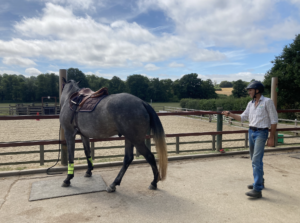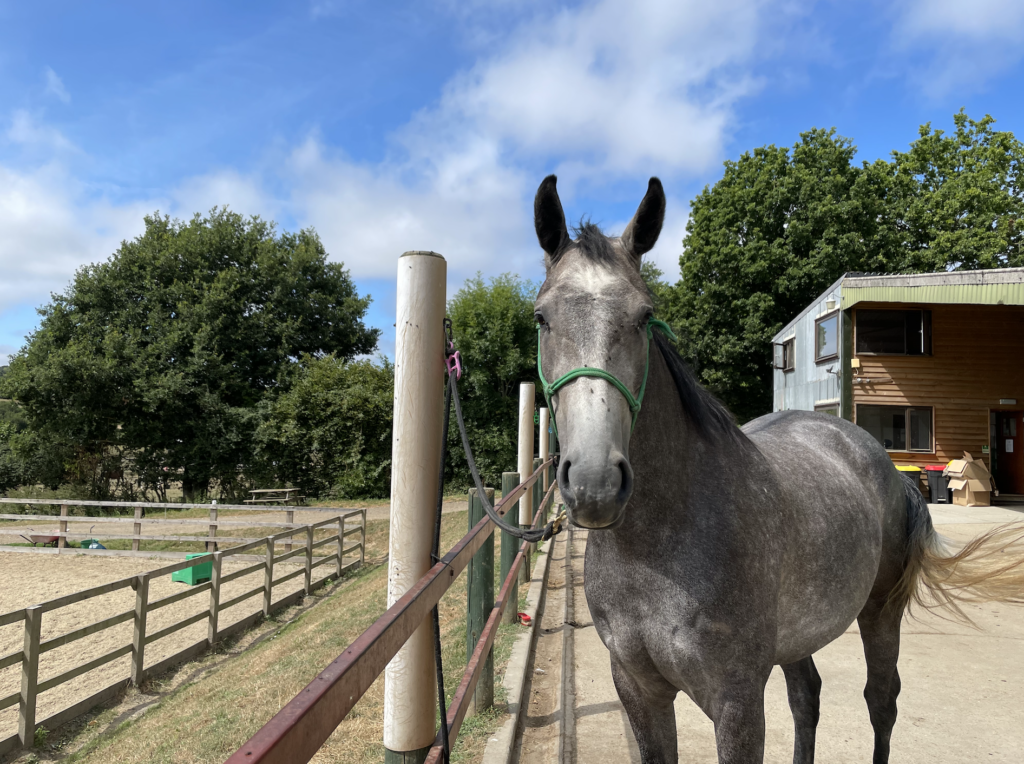Do you have problems tying your horse up? Is your horse unsettled when tied up?
At a recent clinic, one rider unloaded her horse and tied him to the side of the lorry ready to tack up. He promptly snapped the bailer twine and cantered around the car park with a look of triumph on his face! If this sounds familiar, then read on!
One of the first things we teach a horse (or foal) is how to tie up, so it is important that we get it right from the outset. Within the FT 1 – Respect and Control on the Ground Course, I have a whole module on tying up in order to teach your horse to tie up patiently and safely. I also have re-education videos on settling your horse on the tie, and dealing with separation anxiety.
What you need to get started
It is possible to train your horse to stand quietly on the tie with a normal halter, rope and string. However, the following items of equipment makes it a lot easier, in particular, the Safe-Tie and Clip. They can all be purchased through our shop.
What is a Safe Tie?
This is the training aid I use at my training centre, in my horsebox, and anywhere else I might tie a horse up! It is simple, safe and anyone can use it. The Safe Tie allows horses to pull back without injuring or freeing themselves. At the same time it creates enough resistance as they pull back to make the horse want to step forward in order to release the halter pressure. For the horse who simply pulls back because it can (like the horse I described from the clinic!), the Safe-Tie calls their bluff and they quickly stop attempting to break free; it’s simply too much hard work. For young horses, the tie doesn’t frighten them as they don’t feel restricted. It is the perfect alternative to tying solidly (which can cause serious injury) or with bailer twine, which will break and teach them to pull back. Have a quick watch of this video to learn more about how to correctly tie a rope halter and use a Safe Tie.
Teaching Your Horse to Tie up Safely
You will notice that in the FT 1 – Respect and Control on the Ground Course that the Tying Up Module comes last in the course. It is imperative that your horse is desensitised to ropes and human contact, and fully understands how to lead correctly and willingly. Before you tie your horse up, they need to understand how stepping forward will release halter pressure on the poll. The reason for this is that if they do pull back, they will meet steady resistance from the safe-tie. I want them to quickly learn that this resistance goes away when they step forward. Even the most experienced horse can benefit from recapping these lessons; you never know what might spook them and cause them to pull back!
How to stop the Fidget
Do you have, or know a horse that just doesn’t settle on the tie? When I am training young horses, they spend some time on the tie before and after they have been worked. They get used to other horses coming and going, and learn to relax when they are tied up. Hopefully, this will also mean they will stand quietly at events in the future! However, some horses need some extra training to settle them on the tie, which can be viewed in the Tying Up video lesson within the Re-Education Course.
This technique uses a long lunge whip without the lash as an extension of your arm. Once your horse is tied up, tap your horse on one hindquarter (make sure you are out of kicking range!) to move your horse away from you and over to the fence. Once they move away from the tap, stop and let them stand in that new position.


Walk behind them, keeping a safe distance and touch the fence or wall on the other side, which may simulate them to want to fidget again. If they move before you reach the fence walk back to the other side and tap the hindquarter again to move them back. You will have this “conversation” with your horse until you can position your horse and they stay in that position as you move around them. And don’t forget to do it from both sides of the horse! This exercise really does need you to be calm, consistent and decisive in your movements, and to stay very patient… it may take a few days of little and often repetitions!
This exercise is also excellent for settling horses that have separation anxiety, and for those that are difficult to settle on the horsebox. You will see the same techniques adopted in the Separation Anxiety video lesson and the Six Step to Loading, Traveling and Unloading video lesson within the Re-Education Course.
In summary, teaching your horse to tie up and settle on the tie is so important in order to keep you and your horse safe and stress-free at home and at events. Some “hotter” horses are naturally more prone to pulling back, or fidgeting on the tie, but with consistent handling, repetition of the lessons and use of the safe-tie, you will have your horse snoozing on the tie in no time!
